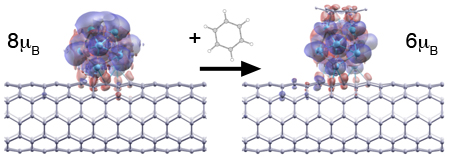Magnetism in Carbon-based nanostructures is an highly debated scientific issue. In collaboration with Prof. J.-C. Charlier we have used DFT and NEGF techniques to show that, in defected Carbon Nanotubes (CNTs), reconstructed mono- and trivacancies with unsaturated carbon bonds behave like magnetic impurities. Due to a long-range interaction between the magnetic defects, conventional calculations with “periodic boundary condition” (PBC) are intrinsically inadequate to describe the magnetism of defected CNTs. We have addressed this issue by developing a computational technique based on NEGF which uses an “open system” to compute magnetic properties and permits the unambiguous determination of the magnetic moment of an isolated magnetic point defect [Phys. Rev. B 81 165406 (2010)]. This result is general and applies to systems where the long range exchange coupling (RKKY model) between the magnetic impurities is mediated by conduction electrons, as in graphene, graphene nanoribbons (GNRs), and other (organic or inorganic) metallic nanostructures with magnetic dopants.
In the same theoretical framework we have shown that magnetism can be induced in CNTs after decoration with transition metal magnetic nanoclusters (NC). These metal-organic hybrid structures (CNT–NC) make efficient spin injection compatible with low-resistance contacts, a crucial feature for spin-dependent transport applications. Going further, we have proven that the adsorption of a benzene molecule drastically modifies the CNT-NC magnetization. Based on this finding, we proposed a novel technique for single-molecule detection based on local magnetic moment measurements [ACS Nano, 6(12) 10786 (2012)]. This approach exhibits an extraordinary sensitivity to gas molecules compared to conventional methods relying on macroscopic conductivity measurements performed on CNT mats.
Publications:
- Z. Zanolli, C. Niu, G. Bihlmayer, Y. Mokrousov, P. Mavropoulos, M. J. Verstraete, and S. Blügel, Hybrid quantum anomalous Hall effect at graphene-oxide interfaces,
Phys. Rev. B 98, 155404 (2018) - Zanolli
Graphene-multiferroic interfaces for spintronics applications,
Scientific Reports, 6, 31346 (2016) - Z. Zanolli and J.-C. Charlier
Single-Molecule Sensing Using Carbon Nanotubes Decorated with Magnetic Clusters
ACS Nano, 6 (12), 10786–10791 (2012) - Z. Zanolli, Giovanni Onida, and J.-C. Charlier
Quantum spin transport in carbon chains
ACS Nano 4 (9), 5174–5180 (2010) - Z. Zanolli and J.-C. Charlier
Spin transport in carbon nanotubes with magnetic vacancy-defects.
Phys. Rev. B 81, 165406 (2010) (6pp).




